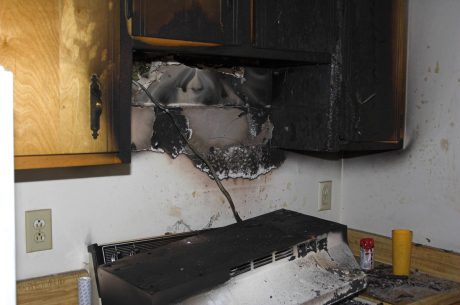Table of Contents
Cleaning fire damage isn’t just a chore—it’s a crucial, high-stakes job that impacts your health, home, and peace of mind. Below, we explore why even small fires demand professional attention and how expert cleanup can save you time, money, and stress.
Cleaning Fire Damage: Why Immediate Action Matters
The moment flames are extinguished, your home enters a critical window. Smoke residue, soot, and toxic ash settle fast—and the clock starts ticking. Delaying professional cleanup increases risk of structural damage, lingering odors, and health hazards.
1. Hidden Toxicity: Why DIY Fails on VOCs & Soot
Smoke leaves more than black residues—it’s laced with volatile organic compounds (VOCs) and microscopic soot particles. These toxins can enter your lungs, trigger headaches, allergies, and even long-term respiratory issues.
Professionals use industrial HEPA filters, ozone generators, and thermal fogging to neutralize VOCs—techniques virtually impossible with household sprays. Without them, your home may never fully recover.
2. Structural Integrity: What You Can’t See Can Hurt You
Fire often weakens wood, drywall, and beams beneath the smoke stains. These hidden dangers include:
- Warped framing
- Cracked drywall
- Compromised load-bearing elements
Pros use moisture meters, thermal imaging, and structural probes to detect invisible weaknesses—preventing collapses and costly rebuilds.
3. Water & Mold: The Secondary Damage Threat
Firefighting introduces hidden water damage. Within 48 hours, mold starts growing—damaging ceilings, floors, and walls. Moisture remediation is essential to halt this second disaster.
Professionals deploy high-powered dehumidifiers and drying equipment and follow mold remediation protocols. DIYers often overlook rebuildable moisture, setting the stage for mold outbreaks.
4. Specialized Soot Removal Methods
Soot isn’t dirt—it’s oily, acidic residue that corrodes metal, fabric, and wood. Ordinary cleaners just smear it around. Professionals rely on techniques like:
Soot isn’t dirt—it’s oily, acidic residue that corrodes metal, fabric, and wood. Ordinary cleaners just smear it around. Professionals rely on techniques like:
- Dry chemical sponges
- Soda blasting
- High-pressure HEPA vacuuming
This ensures real soot removal without damage.
5. Air Quality Restoration: Breathing Easier Post-Fire
Even after surfaces appear clean, your indoor air may be toxic. Air quality testing reveals remaining VOCs and particulates. Professionals then cycle air through HEPA and carbon filtration systems—restoring safe breathing conditions for your family.
6. Legal & Insurance Complexity Made Easy
Insurance companies often refuse claims without professional documentation. Certified pros:
- Estimate structural damage
- Document soot, smoke, and mold impacts
- Provide detailed reports for adjusters
This thorough approach maximizes your coverage and avoids denial.
7. Safe Handling of Hazardous Debris
Fire debris can include:
- Melted electronics
- Asbestos (in older homes)
- Lead, cadmium, silica dust
- Carcinogenic polycyclic aromatic hydrocarbons (PAHs)
Professionals are trained to remove, test, and dispose of hazardous materials safely—following OSHA guidelines.
Why “Do-It-Yourself” Falls Short
| DIY Attempt | Professional Cleanup |
|---|---|
| Surface cleaning with household items | Full decontamination with specialized equipment |
| No structural inspection | Moisture, damage, and weakness detection |
| Limited odor elimination | Complete deodorizing and air quality restoration |
| No documentation for insurance | Detailed reporting and smoother claims |
| High personal health risk | Certified, safe process with full PPE and protocols |
Pro Step-by-Step: How We Handle cleaning fire damage
- Assessment & Emergency Board-Up
Secure the property and evaluate smoke, water, and structural damage. - Water Extraction & Dry‑Out
Remove trapped moisture and dry with industrial-grade equipment. - Soot & Smoke Cleaning
Apply HEPA vacuums, dry sponges, and soda blast cleaning. - Odor Removal & Air Scrubbing
Use ozone generators, HEPA and carbon filters to eliminate VOCs. - Structural Repair & Mold Prevention
Replace compromised framing or drywall and treat mold-prone areas. - Final Air Testing
Verify VOCs and particulates are below safe thresholds before re-entry.
FAQs
Q1: How long does cleaning fire damage take?
Answer: Minor damage may take a few days; comprehensive restoration can take 2–4 weeks, depending on structural and smoke impact.
Q2: Will my insurance cover cleaning fire damage?
Most homeowner policies cover professional fire debris removal, soot remediation, and repair. Working with certified pros ensures proper documentation for claims.
Q3: Can items like clothes or furniture be salvaged?
Yes. Non-porous items (glass, metal) are often cleaned and deodorized. Porous contents may need deeper treatments or replacement based on contamination.
Q4: Is it safe to enter before cleanup?
Not usually. Further damage can occur, and soot or chemicals may harm health. Professionals typically recommend staying out until cleanup and air clearance are done.
Q5: What’s the difference between fire damage repair and cleaning fire damage?
Cleaning refers to removing soot, odor, and debris. Repair/reconstruction addresses structural replacement, drywall, wiring, and rebuilding.
Cleaning Fire Damage: Final Thoughts
When you face the aftermath of a blaze, quick action matters. Fire’s legacy doesn’t end when flames go out—it continues through soot, odor, moisture, and hidden structural damage.
DIY cleanup risks:
- Health hazards
- Missed damage
- Voided insurance claims
- Long-term repair costs
But expert cleaning fire damage with HEPA filtration, air-quality testing, structural inspection, and odor neutralization brings your home back to safety, comfort, and confidence.
Why Choose PuroClean of Coral Gables for your cleaning fire damage needs
At PuroClean of Coral Gables, we offer:
- 24/7 emergency response with immediate board-ups
- Certified technicians and industrial-grade tools
- Full deodorization and HEPA-grade air restoration
- Insurance coordination and expert documentation
- Safe debris disposal & reconstruction readiness
We don’t just clean fire damage—we restore homes, health, and hope. Let our experts handle the mess so you can breathe easy again.
Call PuroClean of Coral Gables today at (305) 894-4343 for fast, professional fire damage cleanup.
Click Google map below to view our Google Business Profile.





 PuroClean of Coral Gables
PuroClean of Coral Gables